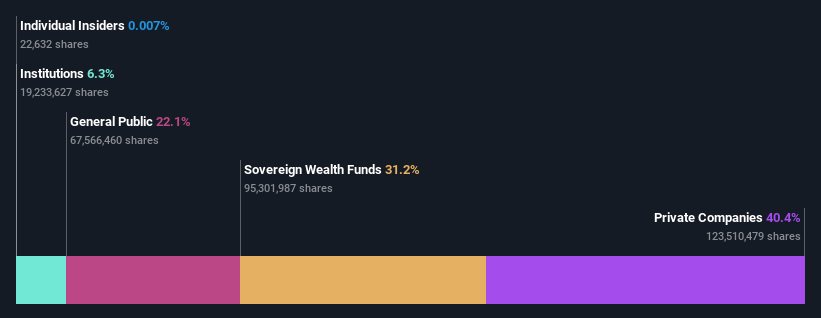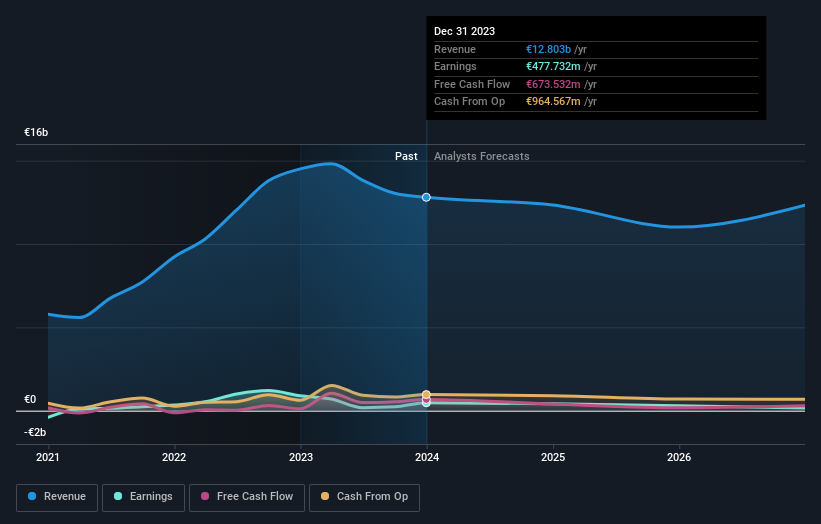Stock Analysis
- Greece
- /
- Oil and Gas
- /
- ATSE:ELPE
HELLENiQ ENERGY Holdings S.A.'s (ATH:ELPE) largest shareholders are private companies with 40% ownership, sovereign wealth funds own 31%

Key Insights
- HELLENiQ ENERGY Holdings' significant private companies ownership suggests that the key decisions are influenced by shareholders from the larger public
- The top 2 shareholders own 72% of the company
- Using data from analyst forecasts alongside ownership research, one can better assess the future performance of a company
A look at the shareholders of HELLENiQ ENERGY Holdings S.A. (ATH:ELPE) can tell us which group is most powerful. The group holding the most number of shares in the company, around 40% to be precise, is private companies. In other words, the group stands to gain the most (or lose the most) from their investment into the company.
And sovereign wealth funds on the other hand have a 31% ownership in the company.
Let's delve deeper into each type of owner of HELLENiQ ENERGY Holdings, beginning with the chart below.
See our latest analysis for HELLENiQ ENERGY Holdings

What Does The Institutional Ownership Tell Us About HELLENiQ ENERGY Holdings?
Institutional investors commonly compare their own returns to the returns of a commonly followed index. So they generally do consider buying larger companies that are included in the relevant benchmark index.
HELLENiQ ENERGY Holdings already has institutions on the share registry. Indeed, they own a respectable stake in the company. This suggests some credibility amongst professional investors. But we can't rely on that fact alone since institutions make bad investments sometimes, just like everyone does. If multiple institutions change their view on a stock at the same time, you could see the share price drop fast. It's therefore worth looking at HELLENiQ ENERGY Holdings' earnings history below. Of course, the future is what really matters.

Hedge funds don't have many shares in HELLENiQ ENERGY Holdings. Latsis Group is currently the company's largest shareholder with 40% of shares outstanding. Meanwhile, the second and third largest shareholders, hold 31% and 1.2%, of the shares outstanding, respectively.
A more detailed study of the shareholder registry showed us that 2 of the top shareholders have a considerable amount of ownership in the company, via their 72% stake.
While studying institutional ownership for a company can add value to your research, it is also a good practice to research analyst recommendations to get a deeper understand of a stock's expected performance. There are plenty of analysts covering the stock, so it might be worth seeing what they are forecasting, too.
Insider Ownership Of HELLENiQ ENERGY Holdings
While the precise definition of an insider can be subjective, almost everyone considers board members to be insiders. The company management answer to the board and the latter should represent the interests of shareholders. Notably, sometimes top-level managers are on the board themselves.
Most consider insider ownership a positive because it can indicate the board is well aligned with other shareholders. However, on some occasions too much power is concentrated within this group.
Our data suggests that insiders own under 1% of HELLENiQ ENERGY Holdings S.A. in their own names. But they may have an indirect interest through a corporate structure that we haven't picked up on. It's a big company, so even a small proportional interest can create alignment between the board and shareholders. In this case insiders own €188k worth of shares. It is good to see board members owning shares, but it might be worth checking if those insiders have been buying.
General Public Ownership
With a 22% ownership, the general public, mostly comprising of individual investors, have some degree of sway over HELLENiQ ENERGY Holdings. While this size of ownership may not be enough to sway a policy decision in their favour, they can still make a collective impact on company policies.
Private Company Ownership
It seems that Private Companies own 40%, of the HELLENiQ ENERGY Holdings stock. It might be worth looking deeper into this. If related parties, such as insiders, have an interest in one of these private companies, that should be disclosed in the annual report. Private companies may also have a strategic interest in the company.
Next Steps:
It's always worth thinking about the different groups who own shares in a company. But to understand HELLENiQ ENERGY Holdings better, we need to consider many other factors. Like risks, for instance. Every company has them, and we've spotted 4 warning signs for HELLENiQ ENERGY Holdings (of which 1 is significant!) you should know about.
If you would prefer discover what analysts are predicting in terms of future growth, do not miss this free report on analyst forecasts.
NB: Figures in this article are calculated using data from the last twelve months, which refer to the 12-month period ending on the last date of the month the financial statement is dated. This may not be consistent with full year annual report figures.
Valuation is complex, but we're helping make it simple.
Find out whether HELLENiQ ENERGY Holdings is potentially over or undervalued by checking out our comprehensive analysis, which includes fair value estimates, risks and warnings, dividends, insider transactions and financial health.
View the Free AnalysisHave feedback on this article? Concerned about the content? Get in touch with us directly. Alternatively, email editorial-team (at) simplywallst.com.
This article by Simply Wall St is general in nature. We provide commentary based on historical data and analyst forecasts only using an unbiased methodology and our articles are not intended to be financial advice. It does not constitute a recommendation to buy or sell any stock, and does not take account of your objectives, or your financial situation. We aim to bring you long-term focused analysis driven by fundamental data. Note that our analysis may not factor in the latest price-sensitive company announcements or qualitative material. Simply Wall St has no position in any stocks mentioned.
About ATSE:ELPE
HELLENiQ ENERGY Holdings
HELLENiQ ENERGY Holdings S.A., together with its subsidiaries, operates in the energy sector primarily in Greece, the Southeastern Europe, and the East Mediterranean.
Excellent balance sheet established dividend payer.

